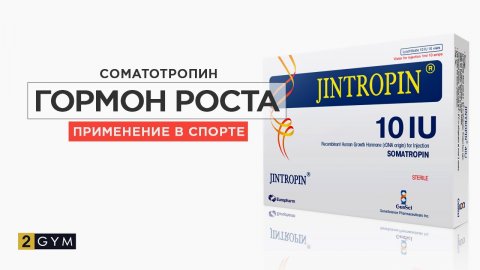General Information
Growth hormone (GH Eng. human growth hormone, HGH) is produced by the anterior pituitary gland of the brain in acidophilic somatotrophic cells. Its production is regulated by several complex feedback mechanisms in response to stress, physical exercise, nutrition, sleep, and the growth hormone itself.
As the name implies, scientists initially discovered that this hormone is responsible for growth regulation in childhood. However, research has shown that growth hormone is also responsible for regulating many other major metabolic functions of the body and acts as an acute phase stress reagent. [1] [2]
Regulation
The hormones listed below are the main factors in the regulation of somatotropin synthesis.
- GHRH growth hormone-releasing hormone, produced in the hypothalamus. Promotes the production and release of somatotropin.
- Somatostatin is synthesized in various tissues throughout the body. It inhibits the release of GHRH, as well as the somatotropin release response to the GHRH stimulus, and enhances hypoglycemia.
- Ghrelin is produced in the gastrointestinal tract as part of the hunger response. Functionally, the ghrelin response protects against hypoglycemia. At elevated levels, ghrelin binds to somatotrophs to stimulate the secretion of growth hormone.
Insulin-like growth factor 1 (IGF-1) also inhibits growth hormone both by directly inhibiting the release of somatotropic growth hormone and indirectly by synergistically increasing the release of somatostatin.
Furthermore, growth hormone negatively affects the hypothalamus, thereby reducing its own production. The effect of this regulatory mechanism leads to a pulsatile release of somatotropin into the bloodstream, which changes hourly.
Generally, growth hormone levels rise in childhood, peak during puberty, and gradually decline with age. [3] [4] [5]
Mechanism of Action
Growth hormone has two mechanisms of action on the body: direct and indirect. The direct action of somatropin occurs by binding this hormone to target cells.
Indirect effects are primarily manifested through the insulin-like growth factor-1, which hepatocytes secrete in response to the binding of growth hormone to surface receptors.
Thus, somatotropin can directly affect tissues; however, part of the effect is mediated by stimulating the liver and other tissues to produce and release insulin-like growth factors, primarily insulin-like growth factor 1 (IGF-1, formerly called somatomedin).
After activation, Janus-activating tyrosine kinases (JAK) bind to latent cytoplasmic transcription factors STAT1, STAT3, and STAT5 and transport them to the nucleus, causing increased transcription and gene metabolism with the formation of insulin-like growth factor-1.
Insulin-like growth factor-1 influences the growth and metabolism of peripheral tissues.
Effects of growth hormone can be considered as the combined effect of the growth hormone itself and the insulin-like growth factor-1, the synthesis of which is increased by the first.
Functions
Growth. Growth hormone causes growth in almost all tissues and organs of the body. However, it is best known for its stimulating effect on cartilage and bones, especially during adolescence.
Chondrocytes and osteoblasts receive signals to increase replication, thus allowing them to grow in size by activating mitogen-activated protein kinases.
Activation of this intracellular phosphorylation signaling cascade leads to a cascade of protein activation. As a result, gene replication and cell growth are enhanced.
Insulin-like growth factor-1 binds to its receptor IGF-1R on the cell surface and activates an intracellular signaling pathway that phosphorylates various proteins. This leads to increased metabolism, anabolism, cell replication, and division.
Additionally, it inhibits cell apoptosis, thereby extending the lifespan of existing cells. The end result is the stimulation of tissue growth and the creation of a hyperglycemic environment in the body.
Metabolism. Growth hormone affects metabolism, primarily by enhancing the production of insulin-like growth factor-1 and its subsequent effect on peripheral cells.
As mentioned above, the activation of intracellular signals significantly affects the main metabolic functions of organ tissues. In general, cells enter a state of anabolism with increased amino acid uptake, enhanced protein synthesis, and reduced catabolism.
Somatotropin also enhances lipolysis. Fats are processed and consumed by stimulating the breakdown and oxidation of triglycerides in adipocytes.
Additionally, growth hormone suppresses the ability of insulin to stimulate glucose uptake in peripheral tissues and causes an increased rate of gluconeogenesis in the liver, leading to an overall hyperglycemic state. [6] [7] [8]
Growth Hormone Deficiency
Growth hormone is extremely important for growth modulation during adolescence. Therefore, significant deviations in the regulation of somatotropin can lead to growth disorders.
Reduced levels of growth hormone may be caused by hypothalamic or pituitary damage during intrauterine development (congenital deficiency) or after birth (acquired deficiency).
Somatotropin deficiency can also be caused by mutations in genes that regulate its synthesis and secretion. Such genes include the pituitary-specific positive transcription factor 1 — PIT-1 or another abbreviation POU1F1.
This gene encodes a member of the POU transcription factor family, which regulates the development of mammals. Mutations in these genes can also cause reduced synthesis and secretion of other pituitary hormones. Several transcript variants encoding different isoforms have been found for this gene.
Sometimes somatotropin deficiency is the result of a GHRH deficiency (growth hormone-releasing hormone). In this case, growth hormone secretion can be stimulated by GHRH infusion.
In clinical practice, there is a test based on the introduction of GHRH with arginine. When this substance is introduced into the bloodstream, it affects somatotrophs, which causes a rapid release of somatotropin. This method is used to diagnose GHD (growth hormone deficiency).
Somatotropin deficiency in adults is associated with increased fat mass and reduced muscle mass, energy, and quality of life. [9] [10] [11]
Excess Growth Hormone
Excess somatotropin in adolescence before the closing of epiphyseal growth plates is characterized by excessive bone growth in length. This condition is known as gigantism.
An excessive amount of somatotropin after the growth plates have closed (in adulthood) leads to the development of a disease known as acromegaly.
In this case, bones stop growing in length, but continue to grow in thickness. In particular, an increase in thickness and deformation of bones occurs in the distal parts of the body, especially the feet, hands, fingers, and toes. Internal organs may also undergo hypertrophy. [12] [13] [14]
Somatotropin excess can also be a paraneoplastic syndrome when some types of tumors produce somatotropin or GHRH.
Increased growth hormone levels can also be caused by tumors of the pituitary gland itself.
Somatotropin overproduction is associated with various health complications, including insulin resistance, hyperlipidemia, cardiovascular diseases, and an increased risk of some cancers.
Acromegaly is often associated with excessive growth hormone production by a pituitary tumor. [15] [16] [17]






